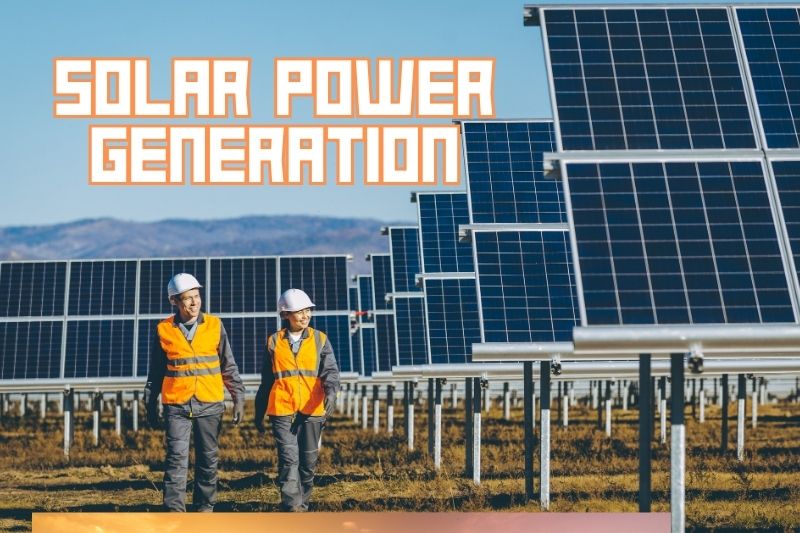Solar power is one of the most promising renewable energy sources available today. Its potential to provide a clean, sustainable, and virtually inexhaustible supply of energy makes it a critical component of the future energy landscape.
But how does solar power generation work, exactly? Let’s find out!
Solar energy originates from the nuclear fusion reactions occurring in the sun’s core, where hydrogen atoms combine to form helium, releasing enormous amounts of energy in the form of light and heat. This energy travels through space and reaches the Earth, where it can be harnessed using various technologies.
Photovoltaic (PV) Cells: The Heart of Solar Power

At the core of solar power generation are photovoltaic (PV) cells, which are the primary components of solar panels. These cells are made of semiconductor materials, most commonly silicon, which can absorb sunlight and convert it into electricity.
When photons, the particles of light, strike the surface of a PV cell, they transfer their energy to electrons in the semiconductor material, knocking them loose from their atoms. This process creates a flow of electrons, generating an electric current.
The Photovoltaic Effect

The photovoltaic effect is the underlying principle of how PV cells generate electricity. Here’s a step-by-step breakdown of this process:
- Absorption of Light: When sunlight hits the PV cell, it is absorbed by the semiconductor material. This energy is enough to excite electrons, giving them the energy needed to break free from their atomic bonds.
- Generation of Electron-Hole Pairs: The absorption of photons creates electron-hole pairs in the semiconductor material. Electrons, which are negatively charged, leave behind holes, which are positively charged.
- Separation of Charges: An electric field present in the PV cell, typically created by the junction between two different types of semiconductor materials (p-type and n-type), separates the electrons and holes, preventing them from recombining.
- Flow of Current: The separated electrons are collected by metal contacts on the surface of the cell, creating a flow of electric current when the cell is connected to an external load, such as a battery or the electrical grid.
Types of Solar Panels

There are several types of solar panels, each with its own advantages and disadvantages:
- Monocrystalline Solar Panels: Made from single-crystal silicon, these panels are known for their high efficiency and longevity. They are, however, more expensive to produce.
- Polycrystalline Solar Panels: These panels are made from silicon crystals that are melted together. They are less efficient than monocrystalline panels but are cheaper to manufacture.
- Thin-Film Solar Panels: Made by depositing one or more layers of photovoltaic material onto a substrate, these panels are lightweight and flexible. However, they are generally less efficient than crystalline silicon panels.
Energy Conversion Efficiency

The efficiency of a solar panel refers to the percentage of sunlight that can be converted into usable electricity. Various factors affect the efficiency of solar panels:
- Material Quality: Higher-quality semiconductor materials have fewer defects, which allows for more efficient energy conversion.
- Surface Reflection: Anti-reflective coatings can be applied to the surface of PV cells to reduce the amount of sunlight that is reflected away, thereby increasing absorption.
- Temperature: Solar panels are less efficient at higher temperatures, as increased thermal energy can reduce the effectiveness of the semiconductor materials.
Solar Power Systems
Solar power systems can be broadly categorized into two types: grid-tied and off-grid systems.
- Grid-Tied Systems: These systems are connected to the electrical grid, allowing excess electricity generated by the solar panels to be fed back into the grid. Homeowners can receive credits for the electricity they supply, effectively reducing their energy bills. Grid-tied systems typically require an inverter to convert the direct current (DC) produced by the solar panels into alternating current (AC), which is used by most household appliances.
- Off-Grid Systems: Off-grid systems are not connected to the electrical grid and usually rely on battery storage to provide electricity when sunlight is not available. These systems are ideal for remote locations where access to the grid is not feasible.
Advances in Solar Technology

The field of solar technology is continuously evolving, with research and development focused on improving efficiency and reducing costs. Some notable advancements include:
- Perovskite Solar Cells: These are a new type of solar cell made from a class of materials called perovskites. They have shown remarkable efficiency improvements and are cheaper to produce than traditional silicon-based cells.
- Bifacial Solar Panels: These panels can absorb sunlight from both sides, increasing their overall efficiency.
- Solar Tracking Systems: These systems can adjust the orientation of solar panels to follow the sun’s path across the sky, maximizing energy absorption throughout the day.

